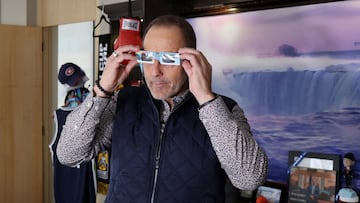How to tell if solar eclipse glasses are fake
As the 2024 total solar eclipse approaches experts warn to watch out for fake safety glasses to observe the celestial event. Here’s how to spot them.

Millions of American will take time out of their day on Monday 8 April to go outside and catch a glimpse of the solar eclipse that will take place. However, without the proper eye protection direct observation of a solar eclipse can cause permanent damage to your eyes.
That is why experts are warning about the danger of counterfeit and fake solar eclipse glasses being sold to the public as excitement for the celestial spectacle builds. The American Astronomical Society (AAS) reminded what to look for in genuine safe glasses and gave advice on how to spot unsafe products.
How to tell if solar eclipse glasses are fake
At simple sight, if the solar eclipse glasses are no darker than ordinary sunglasses, they are fake. But if they are extremely dark and you are still not sure if your solar eclipse glasses are safe, unfortunately “there’s no way to tell just by looking at them whether eclipse glasses are genuinely safe,” Rick Fienberg said.
The project manager of the AAS Solar Eclipse Task Force did however add that “it’s easy to tell if they are not safe.”
READ ALSO: Why is the 2024 total solar eclipse better than the one in 2017?
The *only* safe way to look directly at the uneclipsed or partially eclipsed Sun is through special-purpose solar filters, such as #eclipse glasses or handheld solar viewers. #GAM2024 #ExploreAstronomy #Astronomy #Eclipse2024 https://t.co/52FFA3Qvdn pic.twitter.com/HeWA74sa5i
— American Astronomical Society (AAS) (@AAS_Office) April 3, 2024
Simple test to see if your solar eclipse glasses are “probably” safe
The AAS provides a simple three step test that you can perform before the big day. For step one, put them on first indoors and look around. You shouldn’t be able to see anything as they filter out nearly all light.
At best you may see a very bright light, but it should appear extremely faint through the glasses. If you see furniture or pictures on the wall, they are not safe for solar viewing.
If your solar glasses pass the indoor test, move onto step two. Go outside on a sunny day and put them on but don’t look at the Sun. Look around and you shouldn’t see anything, except again that of a very bright light source. In this case, the reflection of the Sun off a shiny surface. Again it should be quite faint.
If your glasses pass muster then you can move onto step three. Take a quick less-than-a-second glance at the Sun. “You should see a sharp-edged, round disk (the Sun’s visible “face”) that’s comfortably bright,” according to the AAS. “Depending on the type of filter in the glasses, the Sun may appear white, bluish white, yellow, or orange.”
READ ALSO: In which U.S. cities will the April solar eclipse be best viewed?
Related stories
Your glasses are “probably” safe if they passed all three tests. However, if you are still concerned about them use them sparingly during the solar eclipse.
The AAS recommends observing the Moon slowly covering the Sun for no more than 2-3 seconds ever five minutes. And never look through magnifying optics while wearing eclipse glasses.



Complete your personal details to comment